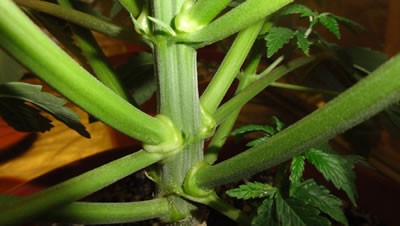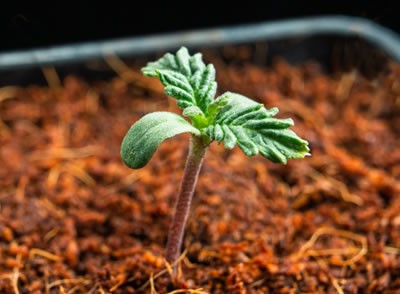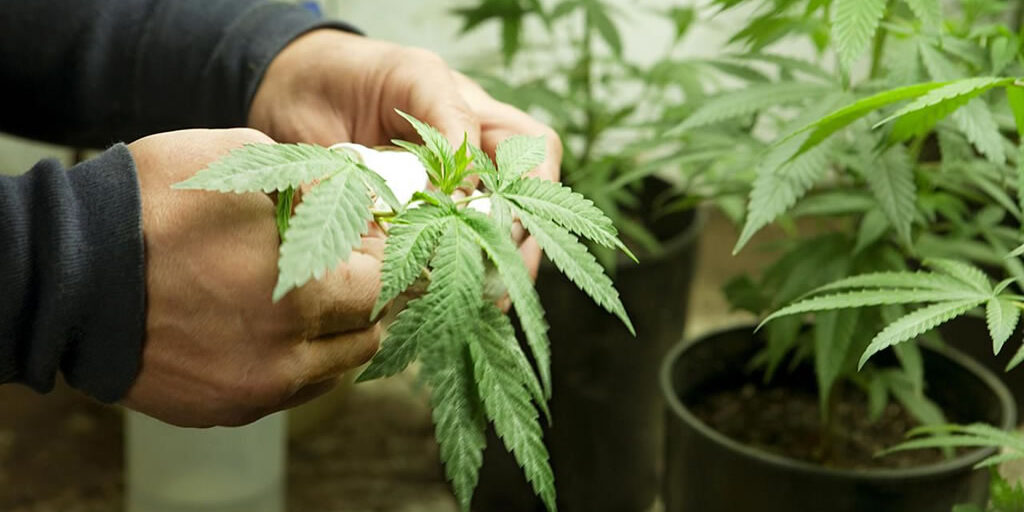The Cannabis Plant 101: Basic Overview
As with anything, it’s important that you do your research before consuming cannabis in any of its wonderful forms. So, we’re going to make that a little easier for you.
Learn everything you need to know about the cannabis plant’s biological makeup and its lifecycle. So, next time you’re looking for your next hit, you know a little more about the science behind the plant.
If you’re interested in checking out some great cannabis strains, have a look at our flower inventory!
The Biological Makeup of Cannabis
There’s a lot of complex terms that are thrown about when you start digging into what cannabis really is. So, here’s a little cheat-sheet to help you know cannabis quickly.
Main stem and branches
 The stem and branches emerge to support the plant’s upward growth. If you’ve ever seen a cannabis plant, you’ll know that’s quite a difficult job. Their jobs are incredibly important as it helps streamline the process of receiving the water and minerals from the roots.
The stem and branches emerge to support the plant’s upward growth. If you’ve ever seen a cannabis plant, you’ll know that’s quite a difficult job. Their jobs are incredibly important as it helps streamline the process of receiving the water and minerals from the roots.
Xylem
The xylem is the part of the plant that’s responsible for pumping those water and minerals from the roots to the rest of the plant. Sort of like a plumbing system, or you may even liken it to the human body’s own internal machinations.
Leaves
The cannabis plant’s fan-like leaves help function as the solar panels of the plant – a key aspect in the photosynthesis process. They absorb the light to turn into energy and help the plant grow.
These leaves also play an important part in allowing us to determine what strain it is. For instance, dark, wide leaves usually point toward the indica strain, while lighter, slender leaves mean you’re dealing with sativa.
Cotyledon
This is the embryonic leaf that occurs in seed-bearing plants. We mentioned the photosynthesis process above and this is the part of the plant that really helps drive the process home in the early stages of growth. After this, the leaves will take on the bulk of the work.
Cola
No, we’re not talking Coca-Cola… A cola refers to the cluster of buds that knit tightly together within the female plant. The cola is made up of many parts: the calyxes hold the plants reproductive organs; the pistils are the reproductive organs themselves; the sugar leaves cover the calyx; and the trichome resin glands – which, you guessed it, hold the THC.
Male and Female Plants
Cannabis plants can be male and female (or both), which aids in the reproductive system mentioned above. The plant that most people are familiar with is the female plant – the queen of the cannabis plants – whose plant produces THC and CBD-rich flowers. The male plants are the pollinators and are usually left out of the growing process. Hermaphroditic Plants have the ability to pollinate themselves, so they tend to be undesirable in the growing process.
Canada’s licensed cannabis producers tend to grow the female plants, above all else.
Growers are able to determine female and male plants once the plants are about 6 weeks old. Male plants begin to grow pollen sacs, sometimes described as false buds. Female plants grow wispy looking hairs called Pistils. Pistils grow out of the Calyx, the Calyx becomes the bud.
FEMALE PLANTS PRODUCE THE BUDS THAT WE SMOKE. MALE PLANTS PRODUCT POLLEN INSTEAD OF BUDS.
It is necessary for growers to keep their male and female plants away from each other as quickly as they are able to recognize them.
When males produce pollen and female plants capture pollen, they spend all their energy attempting to produce seeds and stop putting that energy into growing the buds that we smoke.
Male plants are frequently tossed once they have been identified in order to make sure that female plants can continue to grow buds uninterrupted. When a female plant releases seeds, it is typically a 50/50 split of male and female seeds.
Male Vs. Female Plants – How To Tell The Difference?

A male plant, compared to a female plant of the same strain, normally has a thicker stalk. That is, because it gets taller than female plants and needs to be able to support the weight. They also have fewer leaves than female plants.
A female plant, has fuller bodies of leaves, when compared to males. If you’re trying to sex mature plants, one of the most convenient signs is how bushy they get. Male plants have thicker, sturdier stalks and extremely few leaves. A female of the exact same strain will be much shorter and bushier, with more leaves, specifically near the top.
Check the joints on the stalk for small, clear hairs. When the plant has matured enough, a female will begin flowering. At the joints where the branches fulfill the main stalk, you’ll see little, clear hairs, called pistils, coming out of a small, tear-shaped bud embedded into the joint. Regularly, there will also be “growth tips”, which are new branches and groups of leaves, growing as well.
Male plants will have the little buds (pollen sacs), however will not have the associated hair growing out of it.
Inspect the joints on the stalk for male flowers. The little balls that grow on the joints of the stalk (where the other branches fulfill the main stalk) are the primary indicators of male plants. These flowers release pollen and need to be eliminated for a much better crop.
Know that hermaphroditic (both sexes) plants exist, and need to be treated as males.
Plants can grow both pollen sacs and pistils. If it does, it is hermaphroditic and should be dealt with like a male.
Cannabis plants can grow both sex organs. If you see any of the tell-tale male buds, you ought to trim them like you would a normal male plant. They will still release pollen that can destroy your crop. “Hermies” are usually undesirable plants, and they can destroy a small crop with their pollen if you’re not careful.
The Lifecycle of a Cannabis Plant
The lifecycle of the cannabis plant is not too different from your average plant. But it’s important to know the breakdown if you want to get to the bottom of its biological composition.
Seed (Germination)
As with any plant, the first stage of a cannabis plant is the seed. A cannabis seed should look dark brown (though some can be light in colour) and feel hard and dry. If your seed is green or squishy, it is undeveloped and will not germinate.
Germination can be encourage by watering seeds in a paper towel. When the seed has sprouted, it’s ready to be placed in soil and start the growing process!
After this, it’s just a waiting game to see the plant’s iconic leaves appear.
This stage lasts between 1 and 2 weeks.
Seedling
 It’s hard not to notice the cannabis plant become a seedling because of the fan of leaves that begin to appear. As the plant grows, the leaves it produces will develop more blades – a mature cannabis plant will have 5-7 blades per leaf. Though, some lucky plants do develop more!
It’s hard not to notice the cannabis plant become a seedling because of the fan of leaves that begin to appear. As the plant grows, the leaves it produces will develop more blades – a mature cannabis plant will have 5-7 blades per leaf. Though, some lucky plants do develop more!
If the plant has the desired amount of blades, it’s considered a seedling! As a seedling, the plant will need around 16 hours of light a day. A healthy seedling will be a vibrant green colour.
Perhaps surprising to some will be the fact that the cannabis plant doesn’t need much water to survive. In fact, it’s very prone to overwatering because its roots are quite small.
The cannabis plant can also be vulnerable to disease and mold at this stage. So remember, the cannabis plant you’re smoking was a survivor!
This stage typically lasts between 2 to 3 weeks.
Vegetative
This is one of the longest stages in the cannabis plant’s lifecycle and can last between 3 and 16 weeks, depending on the plant.
In this stage, the plant will still receive plenty of light – 6 of which will need to be in direct sunlight – and will need to be watered a little more regularly. Because of this, the growth will really start to kick in!
This is the stage in which the plant starts displaying sex organs too! It’s important to note the sex of each plant as the male plants can fertilize the female plants. This may not seem like much of a problem, but fertilized cannabis plants can be less rich in CBD and THC content. This is less than ideal.
Sometimes, the male cannabis plants are thrown away, but when kept, they can actually also produce enough CBD and THC content to be equally useful. You just have to get a little more creative with them.
Flowering
The penultimate stage of the cannabis plant is when the plant will begin developing resinous buds and provides confirmation that the effort was worth it.
Most cannabis strains will begin flowering in 8-9 weeks, but some can take a few more weeks to be truly ready. Regardless, when the plant does start to flower, the trichome density will start increasing and the plant gets very sticky.
At this stage, the plant naturally gets less light within the day – decreasing from 16 to 12, as would be expected as summer fades.
Harvesting
Finally, the plant is ready for harvest! And that’s when the real work begins.
Stay tuned for our next blog post: How to Harvest & Store Homegrown Cannabis.
Learn more about Cannabis…
There’s plenty to learn about the cannabis plant and how to safely use it.
So, if you’re interested in knowing more or just don’t know where to begin, we have various articles in our blog. Or you can always head into one of our stores and have a chat!

